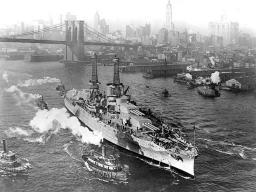- Slug: BC-CNS-USS Arizona, 1st Ld-Writethru,815
- Note: Eds: SUBS 19th graf to CORRECT to courts-martial sted courts-marshal. A Cronkite News Service Weekend Special.
- With: BC-CNS-USS Arizona-Box
- Photos available (thumbnails, captions below)
By IAIN WOESSNER
Cronkite News Service
PHOENIX _ John Anderson remembers rowing into the burning water around the USS Arizona, searching in vain for a twin brother later found among the battleship’s nearly 1,200 dead in the Pearl Harbor attack. But he also has fond memories of his time on the Arizona, such as attending navigation and meteorology classes with shipmates.
Donald Stratton, who left the Arizona’s flaming wreck with two-thirds of his body burned, remembers boxing matches his fellow sailors held next to a trash incinerator below deck.
The Arizona had seen more than 20 years of service by Dec. 7, 1941. On the anniversary of that day of infamy, most remember the ship’s death and not its life. But even though the battleship’s career before the war wasn’t one of glamor and glory, it still holds happy memories for three survivors interviewed by Cronkite News Service.
“The Arizona was, to me, home,” said Anderson, a Roswell, N.M., resident who as of early December was one of 21 Arizona survivors still alive. “The guys that you served with … were all decent guys and friendly fellows, just like a neighborhood high school football team. They worked together, tried together and, in our case on the Arizona, a lot of them died together.”
The third U.S. warship to bear the name Arizona, following a steamer used during the Civil War and a frigate that launched in 1865, the Pennsylvania-class battleship was one of the largest of its day: over 600 feet long, weighing 31,400 tons and bristling with 44 guns, including 12 huge cannons mounted on four turrets.
A delegation led by Arizona Gov. George W.P. Hunt traveled by rail to Brooklyn Navy Yard in New York City for the ship’s launch on June 19, 1915. Hunt selected Esther Ross, the 17-year-old daughter of a Prescott pharmacist, to christen the ship.
The Arizona didn’t see action in World War I when commissioned Oct. 17, 1916, because it was so state of the art: Rather than coal, it burned oil, which was scarce across the Atlantic with the British navy fully engaged.
Then came years of peacetime duty and the Great Depression, which limited military operations.
“It was a training vehicle,” said Luke Bate, education curator at the Arizona Capitol Museum. “The ship was fairly inactive.”
Bate also described the Arizona as a “floating embassy” whose highlights included playing host to foreign dignitaries and ferrying President Herbert Hoover on a trip to the Caribbean. It was even featured in a movie, “Here Comes the Navy,” a 1934 romance starring James Cagney.
The ship made a number of international cruises, visiting France, Turkey, Panama and Peru. It operated primarily out of Southern California, participating in maneuvers in the Pacific before anchoring in Pearl Harbor before the war. Its last training action was a night fire exercise with the battleships Nevada and Oklahoma the evening of Dec. 4, 1941.
In the months and days leading up to the Pearl Harbor attack, life on the Arizona, like that of most naval ships was dominated by routine, the three survivors said.
“The first thing you’d do in the morning would be to go up on deck and clean it,” said Milton Hurst, who was in a crew manning one of the battleship’s turrets.
Hurst recalled testing the guns, playing on the Arizona’s baseball team, being just another sailor.
“I don’t have any great sea stories to tell, but I guess it did for me what needed to be done to me,” he said from Jacksonville, Fla. “I was just an old farm boy _ hell, I had absolutely zero sophistication. All I knew was work.”
“I enjoyed it,” Stratton said from Colorado Springs, Colo. “After all was said and done … after I got squared away and made a few friends aboard, and the routine was settled down, everything was kind of kosher.”
Marshall Trimble, Arizona’s official historian, said scandal shattered the Arizona’s routine in 1924, when news broke that a prostitute named Madeline Blair had stowed away on the ship during a cruise, paying the ship’s cook for meals and doing business with sailors.
“It was the most action the ship saw until Dec. 7, 1941,” Trimble said in a phone interview.
The scandal resulted in courts-martial for 23 sailors, and one was sentenced to 10 years in prison.
“They got after the sailors more than they did her,” Trimble said. “I couldn’t believe that. I thought that was an awful stiff penalty for what they did.”
The Arizona’s lasting legacy, of course, is as a reminder of America’s determination to prevail after Pearl Harbor and as a tomb for many of those killed there, Trimble said.
“That battleship became a symbol of a sneak attack, of being unprepared _ being caught with our proverbial pants down,” he said. “I think the Arizona stands for that as a symbol of vigilance in a mean world.”
^___=
PHOTOS: Click thumbnails to see full-resolution images.

The USS Arizona sails the East River in New York City during its sea trials, around 1916. The battleship served more than 20 years before its destruction Dec. 7, 1941, and its history included a movie role and even some scandal. (U.S. Naval Historical Center Photograph by Enrique Muller Jr.)

The USS Arizona pitches in heavy seas during the 1930s. The battleship served more than 20 years before its destruction Dec. 7, 1941, and its history included a movie role and even some scandal. (U.S. Naval Historical Center Photograph)

The USS Arizona’s complement poses on the battleship’s forecastle, forward turrets and superstructure in this photograph taken around 1924. (U.S. Naval Historical Center Photograph)